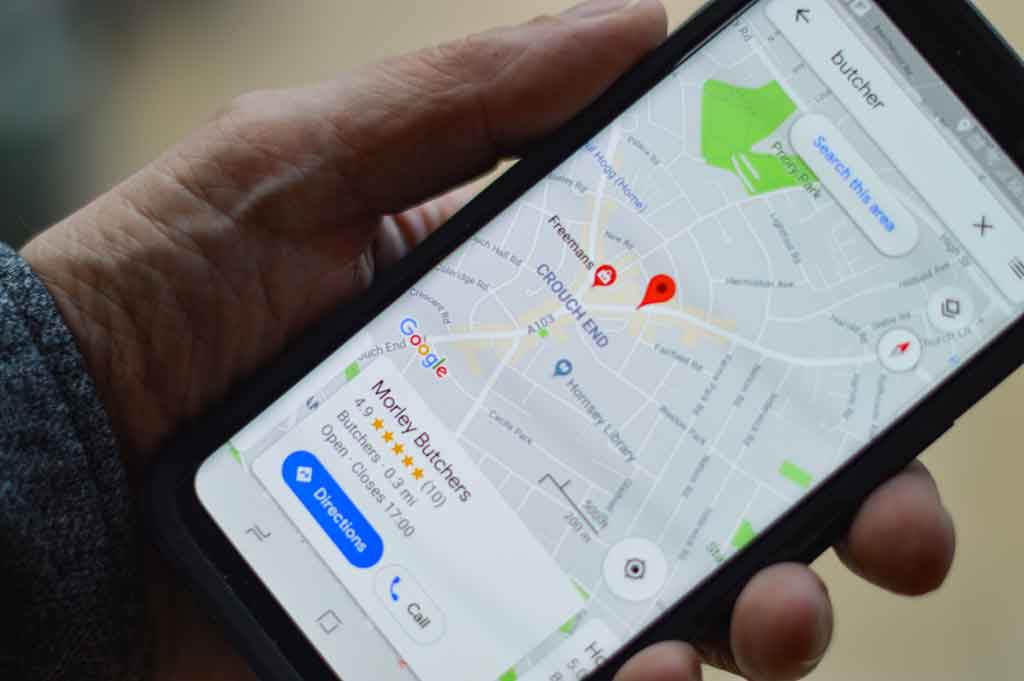March 2022
The Importance of Google Reviews: Part 5
Google Reviews for Local Businesses

Photo by Mitchell Luo on Unsplash
Small businesses now rely on Google as the first landing place for potential customers searching for their product or service. Deyan Georgiev writes in his 2021 article that “when searching for a local business, 60% of customers check Google for reviews”. This is a large leap from where Google started in the early 2000’s competing with Yelp, Amazon, Facebook, and TripAdvisor.
“Google is the top review site in the US, both in terms of traffic and review volume...Nearly 70% of all online reviews are written on Google (local guides have been instrumental). Compare that to Yelp with 2% and Facebook with 7%. The report also points out that average ratings on Google tend to be higher than on other platforms. The average rating on non-Google review platforms is roughly 3.7, whereas it's 4.5 on Google. This discrepancy is due in part to Google's limited review policing and a higher incidence of review fraud on the site vs. Facebook or Yelp” (Sterling, 2021).
Based on this data, you can understand the gap that now exists between Google and the other review sites competing in the space. Dominating 70% of the market positions Google as the thought leader by default. Whatever changes and implementations Google makes to the online review system will dictate the direction online reviews move in the future.
Because Google reviews are tied directly to your Google Business Profile, other tools have been integrated into this system as well. Google Maps, Google Timeline, and Google Notifications have all become a part of the Google Business Profile system. By integrating all these features, the usefulness of Google Business Profile has increased significantly. The most crucial of these features being Google Maps. "Today, Google’s map includes the streets of every nation on earth, and Street View has so far collected imagery in a quarter of those countries” (Norman, 2021).
With such a powerful navigation tool, Google was able to map out different business locations to pair with its search function resulting in the ability for users to search “food near me” and Google will locate local restaurants. Reviews are a natural extension of those search results, giving users the ability to compare local restaurants through reviews, ratings and detailed customer feedback.
Google has taken a significant lead against its competitors in the online review space, and in the meantime, has continued to innovate and add new tools and features. Although the business world will forever be a landscape constantly subject to change, for the foreseeable future, Google will remain the industry leader in the online review space. This is all the more reason why business owners need to utilize the benefits Google reviews and the Google Business Profile.

Photo by Henry Perks on Unsplash
The Importance of Google Reviews: Part 6
Negative Online Reviews
Be understanding, and take the conversation offline

Photo by Cytonn Photography on Unsplash
The goal for any small, medium sized, or large business should be to build a solid reputation over time and develop customer relationships that foster strong, positive, and organic online reviews. As with anything in life however, you must learn to take the good with the bad. The biggest challenge Google Business Profile presents for companies is it provides a public platform for any reviews, including negative reviews. Don’t fret! Understanding negative reviews is part of the process in bettering your business and a few bad reviews will not make or break you. What’s most important is how you respond to negative online reviews.
In the event you do receive a negative review, how you respond will help shape your perception by customers, and potentially solve the issue at hand. Here are some tips Google suggests for How to Respond to Negative Reviews.
- Research your customer’s experience with your business before responding, so you know what may have gone wrong.
- Respond in a timely manner. Customers will appreciate a prompt response.
- Stay professional and courteous. Never lash out - avoid taking the review personally.
- Be honest about mistakes made, and steps you’ve taken (or will take) to remedy the situation.
- Apologize when appropriate, but don’t take responsibility for things that were not your fault. Show compassion and empathy for the customer.
- Offer to talk it over offline. Let the customer know you'll email or call them to discuss the matter in person.
- Show that you’re authentic and genuine. Sign off with your name or initials to show you’re taking the matter seriously and that a real person is listening.

Photo by Markus Spiske on Unsplash
It is important to note that negative reviews cannot be deleted unless they violate Google’s content policy or the customer decides to edit or delete the comment. Therefore, your company’s response is critical in managing customer complaints and feedback. Engaging with a disgruntled customer quickly will often give you the opportunity to remedy the situation before it’s too late!
Something to keep in mind regarding Google reviews is that anyone with a Google account can post a review or give a rating of your business. It does not necessarily need to be a customer. Amazon, for example, adds "Verified Purchase" when an actual customer posts a review. Google, however, does not adhere to this same regulation.

Imagine Google reviews as a tool to rate and review any interaction with a company, rather than a place for strictly “customer feedback.” For example, a disgruntled business owner located in your same business park could leave a negative review on your Google Business Profile due to one of your employees taking their reserved parking space. Although this person isn’t a customer, they still had an interaction with your business, and are able to post a Google Review about their experience.
The best move when receiving negative feedback on Google is to take it offline. You don’t want to get into a public spat with anyone, let alone a customer. Let the person know you'll connect with them directly via email to resolve the issue. Respond in a timely and professional manner, and communicate your goal of resolving things. Other customers will see this and be more confident in trusting your business. By following the guidelines provided above, you can rest assured that you won’t be putting out any major firestorms on your Google Business Profile.
Straight From the Top
Feedback rises to the level of the person asking
LoyaltyLoop’s settings pages give you the power to control your messaging to your customers. You can edit your Survey Invite Email, your Reminder Email, Follow-Up email and so on. All of which your customers see with each launch.
You may not give much thought to your Survey Invite, but it’s important to understand it’s significance in your feedback loop. Your Survey Invite is the first thing your customer will receive during each feedback/review cycle (aka a “survey launch”). Your invite sets the entire tone for your request for feedback, and as such carries special significance. The wording of our default invite remains unchanged for many of our customers thanks to the tests and tweaks we’ve performed over time; the “appeal and promise” to your customers is clear, concise, and simple. However, you should review your Survey Invite from time to time, to ensure it is still reflective of you and your business. Here are a few things to keep in mind:
1 Feedback rises to the level of the person asking
In general, your invitation should be penned from you as the owner, or from senior leadership of your business. The customer needs to know that their feedback is being requested from, and will be heard by, the final authority in the business – meaning, someone who can affect change. This is especially important in the cases where a client has a poor experience, it gives the impression that a complaint won't be discarded or intentionally hidden from someone in charge.
2 Customers don't like to "jump" someone's head
You may think you want to set CSRs or Sales Reps as the sender, since your customers may interact with them on a regular basis. However, if a staff member is the person making the request for feedback, customers are unlikely to “jump the head” of that person and provide feedback beyond their scope of responsibility. Also, if the customer is having an issue with the staff member, they will most certainly not provide feedback on that topic, leaving you blind to client relationship issues. Your goal is to seek unfiltered feedback that covers your customer’s entire experience, not just their experience with one person. When the request for feedback comes from the “Owner” or “President”, they know the proverbial buck stops with you.
3 Pen your invite as you would any other email from you
Your Survey Invite should appear to your customers like any other transactional email you might send to them. When composing your invitation, make certain it reads like it’s coming from you. We all compose emails differently, from the greeting, the words we choose, and our signature. Ensuring this level of personalization helps to reaffirm that you, the owner or senior leader, is in fact the person making the request for feedback. If it’s your practice to add graphics to dress up your emails, then by all means use them in your Survey Invite. But otherwise, avoid making your Survey Invite appear to be a marketing email. It should appear like any other transactional email you might send to your customer.
Continuous Improvement Plans and LoyaltyLoop
LoyaltyLoop can play an important part in your Continuous Improvement Plan. But you may just be asking, what is a Continuous Improvement Plan? Business Professor explains:
“A continuous (continual) improvement plan is a string of processes and procedures that a company puts in place to improve its services and products. This plan entails an on-going review of a company's products and services with a bid to take actions that will improve them.”
When you work day-to-day to meet the needs of your customers, selling products and services, and providing great customer service, you can miss the forest for the trees. You see only what is in front of you. Collecting feedback about your hard work from your customers can give you the objective view you need to know if your work is making a difference. Forbes describes the Continuous Improvement Plan cycle:
Plan
Spot room for improvement, and develop a plan for change.
Do
Implement the change on a small scale as a test.
Check
Look at the results of the change and determine its efficacy.
Act
Take action depending on the results you observed—implement the change broadly or revisit the cycle to spot more room for improvement.
Now let’s look at an example of a Plan-Do-Check-Act (PDCA) cycle, such as when you're reviewing your customer feedback.
Plan
After reviewing your customer feedback, you identify multiple customers mentioning, or complaining, about late shipments for items ordered.
In recognizing this issue, you identify what you believe to be the root causes, and you plan to make the corrective improvements to your internal processes.
Do
You implement your corrective action plans, making changes to your internal processes, but only for a specific line of business, and/or for a limited period of time sufficiently long enough to test the changes.
Check
Based on additional feedback and your overall plan, you review the results of your test.
Customer complaints regarding late shipments have been eliminated, and your shipping times have improved.
Based on the test, it appears the corrective action fixed the issue. You apply any fine tuning to your corrective actions, and review what you learned for the benefit of you and your team during future continuous improvement cycles.
Act
Lastly, based on your plan, the test, and your learning, you fully implement your corrective action plan across the company.
You continue to monitor this process to ensure the changes have the long-term desired effect. If the change needs further work, modify your plan on the smaller scale and repeat the PDCA cycle until you see expected improvements.
Apply this same PDCA process for other issues based on customer feedback. As you execute these improvements, close the loop with your customers. Remember to let them know how their direct feedback led you to this continuous improvement. Doing this type of PDCA process based on real customer feedback will help you to deliver outstanding customer experiences, wow your customers, and build a strong business and brand.
April is Customer Loyalty Month!

Photo by Melissa Askew on Unsplash
In Chicago, Holly McGuire is the editor-in-chief of a 752-page book that lists all the special days, weeks, and months of the year, Chase’s Calendar of Events. If you want to know when to celebrate National Champagne Day, Make Up Your Mind Day, or National Splurge Day, she’s your woman. And you’ll be pleased to find that April is International Customer Loyalty Month!
Sure, it isn’t a holiday in which the banks close and we gather the family around Quickbooks on a warm laptop… It’s a simple and mindful calendar event so you show your appreciation to your loyal customers.
In Chase’s, Shep Hyken writes:
INTERNATIONAL CUSTOMER LOYALTY MONTH. Apr 1–30. We highlight this month to honor and generate customer loyalty! Even though building customer loyalty should be a year-round thing, not just a month, take this month to strategize on how you can improve on relationships with your customers through better service, higher quality, etc.
And Hyken’s right, every month is Customer Loyalty Month. Forbes, citing statistics that show how easily you can lose loyal customers, recently wrote, “Loyalty is up for grabs.” Hyken lays out strategies to keep your customers loyal:
Loyalty = Great Service + Confidence
Consistently putting in the work so your customer service is top notch every time. When your customers experience your high level of consistent customer service their confidence in you grows. The customer becomes loyal because they know every time, 100% of the time, they will receive unmatched customer service.
Create a Demanding Customer
You want to create an experience for your customer that is so extraordinary, that should they go elsewhere, your competitors would find them too demanding. Your customers become loyal because they find your competitors just aren’t willing to go the extra mile.
And what better time to show your appreciation to your loyal customers. Here are some simple ways to show thanks:
- Words of gratitude: Let your customers know you recognize their loyalty. When you interact with your loyal customers consider phrases like, “Thank you for being a long-time customer.” Or, “Thank you for choosing us over the years.”
- Little gifts: Consider sending some fun promo items like t-shirts, drink coasters, gift cards, notepads or other useful items along with a thank you note. Consider gifting them service or product upgrades. Or simply send them cards thanking them for years of patronage. Receiving cards outside of the holiday season will make them more memorable.
- Social praise: If your customers are businesses, review them on social media. Everyone is hot for reviews, and this won’t cost anything. Praise them in public for being loyal customers. Remember, it’s not enough to create just satisfied customers.

Photo by Hanny Naibaho on Unsplash
You want your customers to love working with your business, and come back again. This is how you build a loyal customer following. Take the time during Customer Loyalty Month to plan out your year, and you’ll create an upward, positive spiral of customer loyalty for the future!

